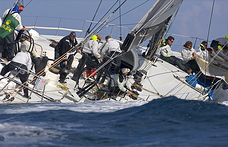I had planned to write something about the importance of teamwork & S&OP & then try & link it to sailing – this would be an easy association. And then a real live incident made the story for me.
We finally set sail again – break in the weather - & planned for a weekend in the “Les Calanques” east of Marseille. These are the steep-sided fjord-like limestone inlets that have been carved out over millennia & make for quite spectacular sailing and anchorages.
Sunday afternoon arrived all too soon & we decided it was time to leave & head for port as more wind was due in the evening & an anchorage was no place to be in a mistral.
So off we went motoring towards the east. There was a slight breeze but not strong enough to sail. We had just left a calanque & were about ½ mile from the coast.
 Then it happened.
Then it happened.
There was a total electrical failure of the engine. The engine was still running but no engine instruments were working.
Then a big mistake.
I stopped the engine to investigate – engine compartments are no place in which to stick your head when they are running. And of course with no electrics, it wouldn’t start again. So we had no power & were steadily drifting towards the coast – sheer rock faces in this case.
I thought of Dad’s Army & considered doing a Corporal Jones impression – “don’t panic ... don’t panic” but instead something strange happened.
Everyone was calm. Margaret & the children quickly raised the sails to catch what little breeze there was – no instruction from me needed. I (relatively) calmly worked out that the engine battery was OK, there were no loose wires in the battery compartment. Then a breakthrough – a loose wire on the engine relay – yep that would do it. There is a spade connector that had fatigued & broken.
So I set about the task of repair. I had spares. But of course no spares the right size. In fact just about every shape & size of spare accept the one that was needed.
We were now drifting close to the rocks; about 100 metres.
We had an emergency process for such an incident (see earlier blog) - deploy the dingy, lash it to the side of the boat & use it to gain some headway. The dingy had the outboard attached & was fuelled & working.
Time to deploy the dingy or could I affect some kind of temporary repair?
In the end, it’s amazing how the proximity of rocks & a possible wreaked boat can spur speedy invention. A temporary connection was made, battery switched on & engine started all in less than one minute.
And we were off & out of danger.
No wild celebrations – yes relief – but we were not out of trouble yet. We maintained a steady speed & didn’t change the engine revs for fear of a different frequency of vibration causing the temporary repair to fail.
By the way, we did consider issuing a Pan Pan at the start of the incident but had an indifferent response in France the last time we did so a few years ago (another story). We didn’t consider a Mayday alert was warranted – maybe it was with the benefit of hindsight.
We headed for the nearest port about eight miles away. A couple of plans were made in the event of another failure - plenty of leeway when lowering the sails for example – neither involved switching the engine off! The port were radioed & informed that we were in potential difficulty.
Sure enough when it came to slowing down to lower the sails (at the last minute before rounding a point into port), the temporary fix failed resulting in loss of engine electrics again. The engine continued & the battery was still charging so I figured that the alternator was still OK.
And we made it safely into port with no further incident.
And what has this got to do with S&OP?
Well we had several contingency plans that came into effect including the tools to make a temporary fix.
However, what struck me was how we reacted & behaved instinctively as a team. No raised voices. No panic – the children were wonderful – “is it time to lower the dingy yet Daddy?” Just calm application & deployment of the plans. We each seemed to acquire a role. And we each executed the role well.
And perhaps therein lies the similarity with S&OP.
S&OP only works for an organisation when the team works. And it’s not just the Supply Chain Team that has to work. It’s the senior management team lead by the CEO. It’s the Commercial Team responsible for the demand side of S&OP. It’s the Make Team where there is a production facility. It’s the Finance team. Everyone needs to understand & execute their role well in order to achieve the desired optimum balance of service & cost.
P.S. The following day a spare spade connector was ‘borrowed’ from Peter (our neighbour & new best friend for the night) & the relay was repaired. Happiness is a well crimped relay connection.
***
In this series:
- S&OP (Sails & Operational Planning) – Consensus
- S&OP (Sails & Operational Planning) – Balanced Scorecard
- S&OP (Sails & Operational Planning) – Defining Customer Service
- S&OP – that’s Sails & Operational Planning
Image credit: Nautic News







